Bikernieki forest on the outskirts of Riga is where the three to five thousand Jews who had managed to survive starvation, the freezing cold, and random executions of the Riga Ghetto were put to death in 1941. Not long after, the same fate would be met by some 30,000 additional Jews from numerous cities in Germany, Austria, and Czechoslovakia who had in the intervening months been transported there to be temporarily warehoused in the newly vacant ghetto.
One might expect that many would be interested in commemorating this tragic history, in particular, the large number of Jewish tourists who we saw at sites associated with the vibrant pre-war Riga Jewish community the week prior. In fact, aside from a few dog walkers and small groups out for weekend constitutionals, members of my family, including my father Morris, himself a Riga Jew, were virtually alone there on a sunny day in early August this year. This is not, apparently, unusual; according to most accounts, Bikernieki receives relatively few visitors.
One part of the explanation has to do with little effort having been made to clearly identify the location of the site or make it accessible. It is most conveniently reached by car, and while the forest appears on maps, no road signs point to the memorial within it, with the result that we spent a good thirty to forty minutes driving around the boundaries of the forest before noticing two black granite markers:
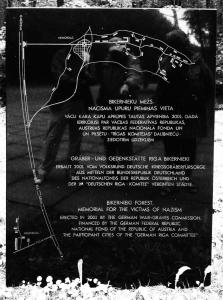

Adjacent to these was a parking area sufficient for no more than a few cars with a narrow path leading to the memorial bordered by a series of pillars. These are inscribed with one of three symbols: the Star of David, a crucifix designating not just the comparatively small number of Christian victims but civilian casualties in general, and what turned out to be a crown of thorns memorializing the political dissidents targeted by the Third Reich.
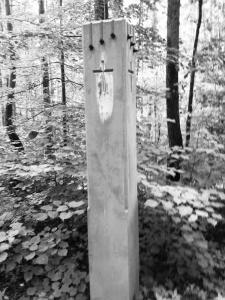
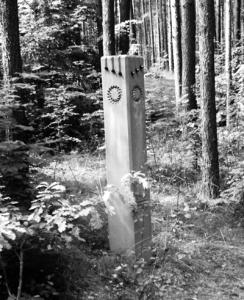
The three commemorative inscriptions carry with it the implication that Jews should be viewed within a broader class of victims, namely, as the more or less official Latvian history of the period would have it, among the victims of the two occupations of Latvia from 1941-1945 and 1945-1990. This is a problematic perspective to be sure, which I will return to, though it (arguably) marks an improvement over the previous memorial erected by the Soviets in the 60s, a plaque mentioning only that 45,000 "Soviet citizens" had perished in Bikernieki — technically true, but plenty misleading, needless to say.
The path winds its way through rather dense forest, with the result that the main monument is entirely obscured from the heavily trafficked thoroughfares bordering the forest on all sides. Upon reaching it, most find it dignified, impressive, and moving. Described by its designer Sergei Rizh as communicating within a "concise language of architectural forms," it recalls the species of accessible modernism of the late Soviet period, better known (at least to me) through musical works by Shostakovich (most notably Symphonies 13 and 14), Schnittke and Gubaidulina: a black granite cube inscribed with a passage from the Book of Job in four languages is surrounded by a quarter-acre mass of upended boulders representing individual lives.
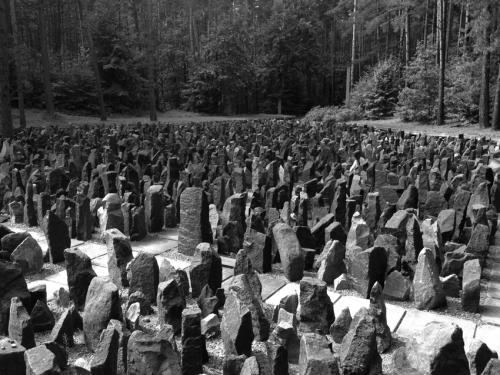
These are divided into plots, each identified by a plaque with the names of cities of the victims of the two waves of the mass executions, Riga, followed by Prague, Berlin, Dortmund, and many others:
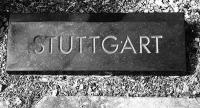 |
 |
|
 |
 |
After entering the main monument, one notices retrospectively that the path on which one approached the site is bordered by concrete bunkers projecting a foot or so above the ground.
And at that point the appalling reality of where one is begins to impinge on one’s awareness. For these were the pits into which Jews were consigned after having been force-marched in herds to the site, those breaking ranks shot en route. The executions were carried out by copious rounds of machine gun fire, heard from early in the morning to late in the evening, with soldiers descending into the pits to insure with their revolvers that no survivors remained.
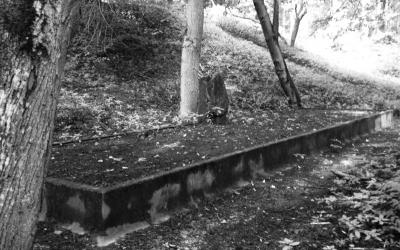 It is impossible to stand next to these without feeling overwhelmed by the addled genocidal enormity of what lies under one’s feet. I suppose the most common reaction is to try to reduce it to a human scale by imagining small episodes within the gruesome reality which transpired. Our seven-year-old son Ben was there with us, his presence recalling eyewitness accounts of parents desperately consoling their terrified children as they were led to their deaths. Morris, who in his childhood photos bears a striking resemblance to Ben, could very well have been one of these children, with my grandmother offering the false reassurance. They were the lucky ones — their immediate family among the very few to have escaped just days before the invasion. That they came so close to death under unspeakably horrific circumstances becomes more present, paradoxically, as the date recedes into the distant past.
It is impossible to stand next to these without feeling overwhelmed by the addled genocidal enormity of what lies under one’s feet. I suppose the most common reaction is to try to reduce it to a human scale by imagining small episodes within the gruesome reality which transpired. Our seven-year-old son Ben was there with us, his presence recalling eyewitness accounts of parents desperately consoling their terrified children as they were led to their deaths. Morris, who in his childhood photos bears a striking resemblance to Ben, could very well have been one of these children, with my grandmother offering the false reassurance. They were the lucky ones — their immediate family among the very few to have escaped just days before the invasion. That they came so close to death under unspeakably horrific circumstances becomes more present, paradoxically, as the date recedes into the distant past.
The other response, which I imagine virtually everyone has, is to repeatedly ask oneself the one word question "why?" The answer which kept re-occurring to me was contained in William Brennan’s statement to his Supreme Court colleagues that he would "no longer tinker with the machinery of death." Brennan was referring to capital punishment which has been a blight on our country for decades. While so far undertaken on a retail basis, its scale two and a half orders of magnitude below that enacted by Hitler, Brennan’s phrase suggests a chilling commonality, which is why it functioned as a kind of silent ostinato for me during our walk through Bikernieki.
For what Brennan came to understand is that capital punishment necessarily entails treating the administration of death as an engineering problem — the most humane configuration of the gurneys and restraining devices, arrangements for last meals, and comparative effectiveness of gas, high voltage electricity, or high doses of barbituates in terminating life.
So too did the designers of Bikernieki devote considerable time and intellectual energy to tinkering with death’s machinery, continually addressing questions such as: were the methods used the most effective means of administering death at the scale necessary, was the harvesting of items of value from the bodies (articles of clothing, jewelry, gold fillings etc.) undertaken with the requisite efficiency, were the bodies disposed of in accordance with the best science available so as to minimize the chances of exposing the surrounding communities to infection or foul odors. Aside from complaints about the noise of the machine guns, there is little reason to doubt that Bikernieki was a very smoothly operating facility. But to ask these questions is "to tinker with the machinery of death" and to contemplate their answer, as Brennan understood, is to consign oneself to the moral sewer.
Insofar as this is so, it seems appropriate that, aside from the memorial, the only visible traces of the products of this debased intellectual labor — the massive, insane civil and human engineering project which was Bikernieki — are the 100 odd concrete death pits which line the entry path. And these are gradually becoming overgrown, to the extent that they will be, in a few years, entirely obscured from view.
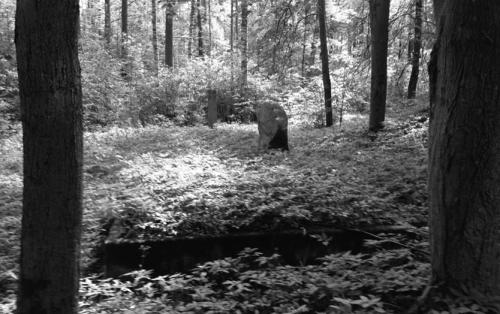
But should they be allowed to become invisible? If so, this would seem to carry the implication that they can be forgotten as nothing more or less than any other tragic episode in the nightmare that is world history.
This is the perspective which would seem to inform the Latvian government’s policy toward Bikernieki. They have, as noted earlier, committed only token funds to maintaining the memorial and have made virtually no effort to make the site accessible or even minimally conspicuous. It may also, however, be a concession to right wing elements within the governing coalition. According to them, the Jews, while victims of the first occupation, were equally complicit in the second one. After all, Jewish Bolsheviks famously included Trotsky, Zinoviev, and even Lenin himself who was one quarter Jew — they will be pleased to point out. Even under Stalin, Jews continued to serve in official positions, including over 140 Generals in the Red Army. Indeed, the Soviet General Friedrich Segal prominently figures in the Riga Jewish museum exhibits of notable Riga Jews eliciting conspiratorial guffaws, one could well imagine, from the Latvian right. All this constitutes the twisted logic according to which the Latvian right wing views its murderous anti-Semitism and collaboration as a form of premature anti-Communism.
This variant of the denialist strategy should by now be familiar, with perhaps the best known example being the French National Front’s attempts at rehabilitation of Vichy supporters on similar grounds. Fascist elements have also reappeared in the Hungarian governing coalition justifying their complicity along lines outlined by iconic neo-conservative Jeanne Kirkpatrick, who famously argued for the regrettable necessity to support "authoritarian" regimes resisting Communist "totalitarianism." While the resurgence of the European right would seem to make more urgent the reference on the granite blocks at the memorial entrance to the Nazis’ "volunteer accomplices," this is clearly insufficient to remind Latvians of the right wing’s historical legacy. That this is the case would seem to constitute strong grounds for maintaining the site and making it more, not less, conspicuous.
On the other hand, in doing so, one advances the agenda of another right wing nationalist project, namely Zionist expansionism for whom Jews’ status as perfect victims has served as a smokescreen behind which the crimes of the State of Israel, by now not unreasonably described as approaching holocaust proportions, have been effectively concealed. For them, no commemoration could ever be commensurate with the enormity of the crime perpetrated against the Jews. Those making any comparison to past holocausts — African-Americans in the Middle Passage, native populations in the Americas, Armenians on Mt. Ararat, and, most notably, the Palestinians in Gaza — to even identify these as such is seen as on a par with holocaust denialism.
The presence of the Holocaust Museum on the Washington Mall is perhaps the most visible indication of "never again" Judaism’s success on claiming a monopoly on holocaust victimhood. It is, after all, just a few hundred yards from where the Dred Scott decision was reached and where the Native American holocaust was planned and administered. Understandably, albeit not justifiably, the only holocaust commemorated on the mall is one which the U.S. Government played at most a minor role in perpetrating, while those which it designed and implemented receive no official commemoration.
Despite the efforts of AIPAC, the ADL and others, recent history and recent opinion polls have demonstrated that "never again" has begun to ring hollow among its intended audience. The Israeli couple who, at breakfast with us that morning, described how, for many years running, they have made yearly pilgrimages to sites associated with the Shoah now seem merely out of touch. Increasingly, Jewish attitudes are likely to be closer to those of Morris, whose only effort to reacquaint himself with the cities of his youth would be a full seventy-two years after his departure: it was only in his 89th year, for the first and last times, that he visited Bikernieki Forest and the Shkeede Dunes outside Liepaja where his grandparents, uncles, aunts, cousins, and childhood friends were put to death.
Why only now? While I have never discussed this with him, at some point, he must have consciously decided against defining himself with respect to his undeniable status as a victim, as have so many Jews. It would have been easy for him to do so: Morris’s personal history involves not just the murder of most of his family in 1941 and 1942, but physical assaults from anti-semitic gangs on his way to school in the thirties, and two decades later, having the windows in our house in Newton broken the day after we moved in by anti-semitic Irish Catholic neighbors (many of whom became close friends, believe it or not.)
But these episodes only tell some of the story, another part of which consists of Morris having seen with his own eyes Jews enthusiastically involving themselves in the right wing movements from which National Socialism derived. Here is Morris at the Riga Jewish museum a few days before.
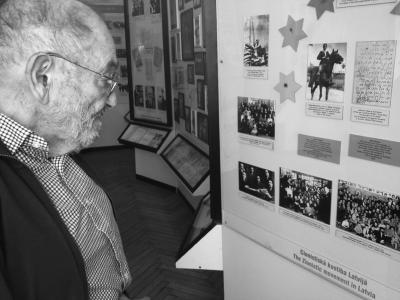
"[Jabotinski’s] Betar actually wore brown shirts, Jewish brown shirts," he is saying to me here.
Morris also mentioned to me that, upon his arrival in New York City, he met Jews who expressed some sympathy for the National Socialist project, though they were critical on the grounds that, according to Morris, "Hitler went too far" in going beyond targeting only the "bad Jews." Given these attitudes, which were, according to him, not all that uncommon among relatively privileged German Jewish emigrés such as himself, it would come as no surprise to him when, in the late 1970s, an alliance between the traditional domestic right wing and neo-conservative Jews would emerge, forming the bulwark of a reactionary political economy we are still struggling to dislodge.
Morris’s refusal to revisit the tragic circumstances of his family should be seen as a continual act of defiance: oppressors have always recognized that their real victory resides in their victims viewing themselves as inalterably shaped and permanently scarred by the injuries they have suffered. And in the same way, in maintaining something approximating the socialist/utopian internationalist commitments of his youth, even while many Jews of his (and my) generation would veer increasingly rightward, was itself a repudiation of Betar who, as he remarked to me, directed their hostility not towards virulent anti-semitic elements in Riga, of which there were plenty, but almost exclusively towards left wing Jewish organizations which he belonged to.
The visit to Bikernieki was harrowing for all of us — most of all, of course, for Morris who, I am told by my cousin, was uncharacteristically silent for the next several days which they were to spend together. It is routine, albeit plenty vulgar, to describe such experiences in Opraesque terms as having "brought closure." In fact, it did nothing of the kind for any of us. Rather our visit brought the recognition that Bikernieki should be seen within a historical continuum, one more battle within a war which is still being fought, with the stakes now higher than ever.


Correction: Justice Harry
Correction: Justice Harry Blackmun, not Brennan, is responsible for the phrase that he would “no longer tinker with the machinery of death.” I regret the error.
Holocaust proportions? Are
Holocaust proportions? Are you nuts? 6 million Jews plus 5 million non-Jews–nearly all civilians–murdered in 6 years vs how many Arabs/Palestinians killed in 65 years? Maybe 70,000? With about 22,000 Israeli dead in the equations?
"Approaching holocaust
“Approaching holocaust proportions” was the exact phrase, and yes, it applies, albeit on a smaller scale to that of the holocaust which victimized my family. E.g “widespread and systematic” use of torture, according to Amnesty International, the broken bones policy of the “dove” Rabin, putting Gazans “on a (starvation) diet”, bombing of civilian targets, making Palestinians “understand in the deepest recesses of their consciousness that they are a defeated people.” Those all too willing to ignore the long and continuing record of Israeli atrocities can try to run from these facts but they can’t hide.
Dear Sirs, · I take
Dear Sirs,
· I take the liberty to inform you about my new documentary about the Riga Ghetto. “After all we survived”-The Riga Ghetto (98 min)
Synopsis: Between November 1941 and October 1942, 24.606 Jews from the “Deutsche Reich” (Germany, Austria, and Czechoslovakia) were deported to Riga. 4.500 were shot on arrival. The remaining Jews were sent to the Reichsjudenghetto and Jungfernhof and forced to live in an area where about 13,000 people had lived previously. However, before the “Reichsjuden” had been deported to Riga, to make room for the new arrivals, some 25,000 Latvian Jews out of 30,000, who had been placed into the Riga ghetto from August 1941 onwards were, over only two days, shot by the Nazis and willing Latvian collaborators. The brutal murder of Latvian Jews was one of the second-worst atrocities in the first stage of the Holocaust and yet, until now, this terrible chapter has rarely been spoken or written about.
Those who survived the ghetto suffered for years after. Out of the 24.606 ReichsJuden who were deported to Riga, only 1,073 survived .
In my new film, German and Latvian survivors speak out for the first time about the massacre against the Latvian Jews, the living conditions in the ghetto and how they survived the trauma.
DVD ordering adress info@phoenix-medienakademie.com (15€)
Details and outtakes (German) http://www.phoenix-medienakademie.com/Riga
Kind regards
Phoenix Medienakademie e.V.
Jürgen Hobrecht
Wörtherstr. 13
10405 Berlin
T. +49/30/48496346
F. +49/30/48496347
mobil 0160 8018904
e-mail info@phoenix-medienakademie
http://www.phoenix-medienakademie.com
I add to the Holocaust I add to the Holocaust proportions comment. You are absolutely delusional. There is no systematic slaughter of Arabs in Israel. World Jewish population went from 15 million to 9 million because of German murderers (plus their native volunteer henchmen). Arab population has expanded almost exponentially in Israel, Gaza and the WB. Your comparison of Israeli responses to terror attacks and an Arab blood lust for dead Jews with the Holocaust is sickening. You should be ashamed but that would imply you had a soul. It’s disgusting posts like yours that fuel anti-Semitism – you are the poster boy Jew proclaiming the Israelis are just like the Nazis. You are sick person. More because you hide behind the shield of victim relative. How dare besmirch their name!
After five years, and based on explicit and overwhelming evidence such as that in the link below, it is now painfully obvious that an apology for this comment in order.
I will expect to receive it from the commenter.
https://www.haaretz.com/israel-news/netanyahu-absolves-hitler-of-guilt-1.5411578
Would be interesting to know if the commenter supports the current president’s attacks on Congresswomen Omar and Tlaib which are, of course, based on a shared assumption of an “Arab blood lust for dead Jews.” Whatever is the case, it demonstrates the distance between the New Politics Schactmanite/Shankerite brand of socialism and the neo-fascist right is smaller than many would be willing to admit. That it can recede into insignificance is something we know from the history reviewed in the piece. The comment is a useful reminder of this fact.
This is pure slander. Calling NP “social fascists,” John? Needless to say, you won’t be writing for us again.
Whatever. New Politics reviewed and published a comment from one of its readers describing “Arab blood lust for dead Jews.” That it was regarded as acceptable indicates where New Politics stood at the time. Would be useful to know if it has changed its position on this matter.
Don’t assume. Your piece appeared in 2013, right? We didn’t review anything on the old site back then. If comments appeared then they appeared, including spam. Only years later did we start approving or not approving comments.